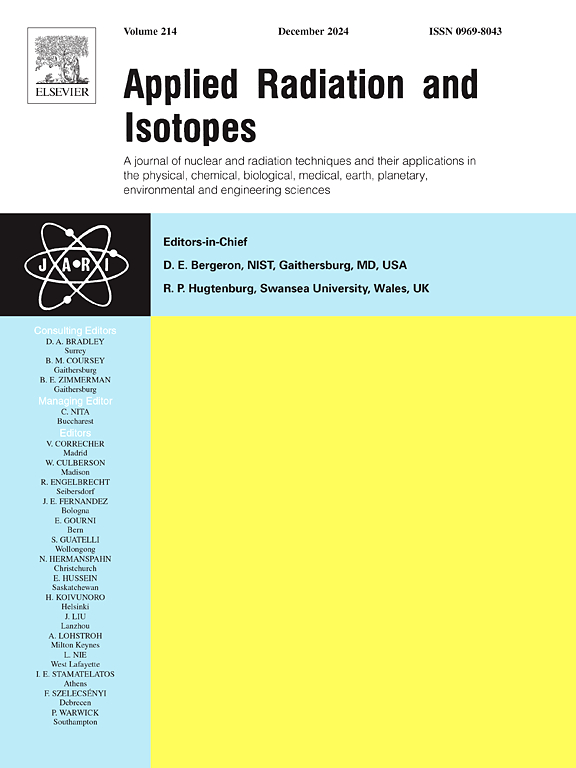新型掺杂gd2o3锌硼碲玻璃体系的结构、光学特性及辐射屏蔽衰减参数的计算
IF 1.8
3区 工程技术
Q3 CHEMISTRY, INORGANIC & NUCLEAR
引用次数: 0
摘要
本研究评估了氧化钆(Gd2O3)掺杂锌硼碲酸盐(ZBT)玻璃在光子和辐射防护中的应用,发现增加Gd2O3浓度可使密度从4.08 g/cm3提高到4.32 g/cm3,并在保持非晶性质的同时提高结构完整性。FTIR光谱鉴定出关键结构单元为(BO3, BO4, TeO3, TeO4, Zn-O),光学分析显示其高可见光透过率大于80%,折射率增加(1.94-2.07),表明其具有光电电位。当Gd2O3含量为1.5 mol%时,光致发光呈现蓝绿色,峰值强度为蓝绿色,表明适合固态照明。在0.015 MeV范围内,物理- x /PSD表现出能量依赖的辐射屏蔽作用,质量衰减系数在37.977 ~ 40.469 cm2/g之间,而在0.04 ~ 0.06 MeV范围内,有效原子序数达到48.48,显示出光电吸收的优势。半值层和平均自由程在较低能量下分别从0.004增加到0.153 cm和0.006-0.221 cm,在8 MeV和8 MeV下分别达到5.446 cm和7.858 cm,反映了从光电到康普顿散射和对产生的转变,证实了较好的低能衰减。这些结果表明,掺杂gd2o3的ZBT玻璃具有高密度、结构坚固性和增强的光学性能,是一种很有前途的多功能材料,可用于先进的辐射屏蔽和光子技术。本文章由计算机程序翻译,如有差异,请以英文原文为准。
Structural and optical features of new Gd2O3-doped zinc boro-tellurite glass systems and computation of radiation shielding attenuation parameters
This study evaluates gadolinium oxide (Gd2O3)-doped zinc boro-tellurite (ZBT) glass for photonic and radiation protection applications, revealing that increasing Gd2O3 concentration enhances density from 4.08 to 4.32 g/cm3 and structural integrity while maintaining amorphous nature. FTIR spectroscopy identified key structural units of (BO3, BO4, TeO3, TeO4, Zn–O), and optical analysis demonstrated high visible transmittance greater than 80 % and increased refractive index (1.94–2.07), indicating optoelectronic potential. Photoluminescence showed blue-green emissions with peak intensity at 1.5 mol% of Gd2O3, suggesting solid-state lighting suitability. Phy-X/PSD revealed energy-dependent radiation shielding with mass attenuation coefficients ranging from 37.977 to 40.469 cm2/g at 0.015 MeV, while the effective atomic number peaked at 48.48 within 0.04–0.06 MeV, indicating dominant photoelectric absorption. The half-value layer and mean free path increased from 0.004 to 0.153 cm and 0.006–0.221 cm at lower energies, reaching 5.446 cm at 8 MeV and 7.858 cm at 8 MeV, reflecting transitions from photoelectric to Compton scattering and pair production, and confirming superior low-energy attenuation. These results establish Gd2O3-doped ZBT glass as a promising multifunctional material with high density, structural robustness, and enhanced optical performance for advanced radiation shielding and photonic technologies.
求助全文
通过发布文献求助,成功后即可免费获取论文全文。
去求助
来源期刊

Applied Radiation and Isotopes
工程技术-核科学技术
CiteScore
3.00
自引率
12.50%
发文量
406
审稿时长
13.5 months
期刊介绍:
Applied Radiation and Isotopes provides a high quality medium for the publication of substantial, original and scientific and technological papers on the development and peaceful application of nuclear, radiation and radionuclide techniques in chemistry, physics, biochemistry, biology, medicine, security, engineering and in the earth, planetary and environmental sciences, all including dosimetry. Nuclear techniques are defined in the broadest sense and both experimental and theoretical papers are welcome. They include the development and use of α- and β-particles, X-rays and γ-rays, neutrons and other nuclear particles and radiations from all sources, including radionuclides, synchrotron sources, cyclotrons and reactors and from the natural environment.
The journal aims to publish papers with significance to an international audience, containing substantial novelty and scientific impact. The Editors reserve the rights to reject, with or without external review, papers that do not meet these criteria.
Papers dealing with radiation processing, i.e., where radiation is used to bring about a biological, chemical or physical change in a material, should be directed to our sister journal Radiation Physics and Chemistry.
 求助内容:
求助内容: 应助结果提醒方式:
应助结果提醒方式:


